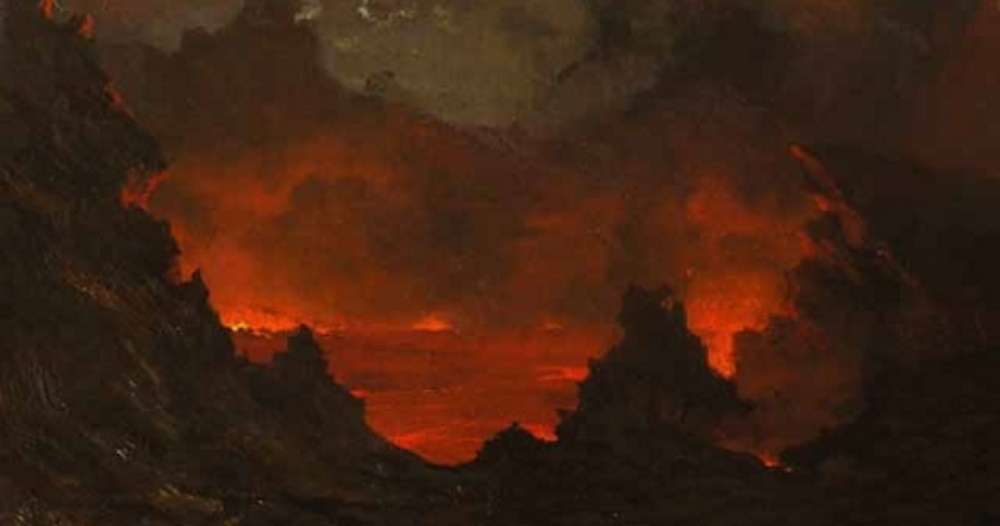As early as 1735, residents living along the New Hampshire-Vermont border reported a New Hampshire volcano erupted violently.
The inhabitants of Fort Dummer in Brattleboro, Vt., gave the story its greatest boost when they reported one night that they heard rumbling. The earth shook, they said, and flashes of light shot through the sky.
It was so jarring that the people at the fort sent out an expedition the next day to scour Mount Wantastiquet in New Hampshire. The mountain, also known as West River Mountain, lies on the border between Hinsdale and Chesterfield.
Near the top of the mountain, the searchers found an indentation and some strange rocks, which they took as signs of an eruption.
Volcanic Scam
The volcano next played a part in an apparent scam carried out by a travelling con man working the area around 1774. He persuaded several residents they could find silver in the earth under the site of a volcanic eruption. For a fee, he would instruct them where to dig.
After prolonged mining at the mountain’s top and at its base, the townspeople concluded that there was no silver to be had. The only thing that had been had was them.
But the story of the volcano went unchallenged.
The New Hampshire Volcano

Full Moon Over Kilauea (1887 painting by Jules Tavernier.
A lawyer named Daniel Jones had colleagues who’d heard about the New Hampshire volcano. They asked him to investigate and report back. So he traveled to the mountain and reported on his findings.
He then found the mountain 12 miles north of the Massachusetts line on the east side of the Connecticut River and opposite the mouth of the West River.
“On the south side of the Mountain, about eighty rods from the summit, there has been an eruption, perhaps not within the present, or last century,” he concluded. “The peasants, in the neighborhood of the Mountain, discovered this place, and became possessed with the idea of gold dust being in the mountain.”
Those peasants, he wrote, believed the gold dust melted into a solid body by the extreme heat of the mountain’s explosion. As a result, they went to work in search of the supposed treasure.
“After fruitless searches, they formed larger connections, entered into covenant with the proprietors of the land, and with one another, to make search for all kinds of mine and mineral.”
Jones concluded something had exploded. He didn’t believe, though, that he saw definitive evidence of a volcano.
Timothy Dwight and the Volcano
The volcano next crops up in Timothy Dwight’s Travels in New England and New York, published in 1821.
Dwight, the president of Yale College, visited Hinsdale, N.H., in 1798 to examine the mountain. He’d heard it was ‘to a very humble degree volcanic.’
Dwight went to see a Mr. Butler of Hinsdale, and he took him to West River Mountain. About 150 feet from the summit they found a pit, 60 or 70 feet deep. The inhabitants had dug it with the hope of finding ‘some species of ore.’
But Dwight reported they could only look down into the pit.
He heard the volcano story from Mr. Butler and some people he’d found at an inn. They told him that 23 years ago, ‘the people of the neighborhood were alarmed by a loud noise, proceeding from this mountain, and resembling the sound of cannon.’
The Pine Tree
“A Mr. Barrett, who visited the place, found a hole, forced through the mountain by a blast, evidently as he thought the result of intestine fire,” wrote Dwight.
Barrett described the hole as about six inches in diameter. Nearby, a pine tree was covered with a black mineral substance. The substance had been ‘forced violently out of the passage,’ he said. It consisted ‘chiefly of melted and calcified iron-ore strongly resembling the scoriae of a blacksmith’s forge.’
Someone had cut down the tree, however, but Dwight saw the substance stuck to the rocks and the earth. The substance couldn’t be broken off without a violent effort, he wrote.
“From the whole appearance it was completely evident that it was driven against the cliffs in the same liquid state,” he wrote.
And, he saw two holes below the pit that he decided animals couldn’t have made.
“They must have been formed by a blast of air from the bowels of the mountain,” Dwight then concluded.
The Volcano Dies Out
Dwight brought specimens of the vitrified ore to Yale, along with some yellow ochre he found.
Over the next several decades the New Hampshire volcano received publicity in newspapers throughout America.
Several decades later, geologists concluded the New Hampshire volcano was not a volcano. Instead, they theorized, the residents heard the sound of a rock slide, and in the darkness they mistook it for a volcano.
But then the story of the volcano gained credibility through repetition over many years until geologists could thoroughly investigate it.
But those who would love a New Hampshire volcano should take heart. Geologists describe the Ossipee Mountains, north of Lake Winnipesaukee, as the remains of a volcanic ring dike.
Ossipee Mountains: By Jrclark at English Wikipedia, CC BY-SA 3.0, https://commons.wikimedia.org/w/index.php?curid=15450885
This story was updated in 2024.




1 comment
‘peasants’?
really?
Comments are closed.